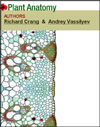
|  |
Preface| Plant anatomy is essentially concerned with the microscopic study of plant structures, and is generally focused on studies of seed plants. The origin of the word "anatomy" implied sectional views of biological objects. The study of plant anatomy is a very visual endeavor, requiring careful observations, understanding critical organizations, and developing a new vocabulary based on plant structure and development. The decision to develop this CD-ROM has been based on the observation that students require time that is often not available in the classroom or laboratory to adequately study microscopic preparations, and laboratory time might be better spent in developing new skills and techniques--such as working with fresh materials. The ability to have views of slides and other materials often studied in the laboratory, but available at nearly any computer, is a great learning advantage.
Textbooks on plant anatomy do not exist with the numbers of color illustrations needed to have a full appreciation of the subject. In addition, books cannot be easily modified as new materials and information become available. Furthermore, although textbooks may have considerable value to convey written and diagrammatic concepts, they lack certain aspects of interactivity. For all of these reasons and more, it was decided to develop subject matter relevant to the study of plant anatomy that can be quickly and easily accessed on a personal computer.
The sequence of topics follows a rather conventional format, but also includes a general review of basic botany useful in studies of plant anatomy, an emphasis on microscopy, plant cell fine structure, selective staining, and image analysis--all of which are not often covered in traditional plant anatomy texts. Yet these topics are natural adjuncts to the classical subject matter, and knowledge of them enables one to better understand and appreciate the role of plant anatomy in modern research. In most cases outside of the "Conceptual Overview" to each unit of study, there is only a moderate amount of text-based material used to describe the illustrations. For additional readings the student is referred to any of several prominent texts on plant anatomy.
There are approximately 240,000 existing species of angiosperms. As a consequence not all variations in structure can be expected to be covered in any introductory study of plant anatomy, nor are they even known. The emphasis of this resource is on the vegetative and reproductive structures of angiosperms, although there are many places where gymnosperms are relevant for comparison. Non-seed plants are generally not emphasized.
It is expected that the student involved in this study will have had some introductory level course in biology, botany or plant biology, but no extensive background is required. However, the materials cover a broad range of topics that require considerable and careful study of images.
The authors have individually created most of the illustrations used in this electronic learning resource. However, the authors also wish to acknowledge the important support and materials provided by Prof. Tom Phillips, Department of Plant Biology at the University of Illinois at Urbana-Champaign, the rare and unusual slides originally organized by Prof. Zane Carothers, and the additional resources of the Department of Plant Biology at the University of Illinois, Urbana-Champaign as well as the Department of Plant Anatomy and Morphology of the Komarov Botanical Institute in St. Petersburg, Russia, the New York Botanical Garden, and Herbert H. Lehman College of the City University of New York, Bronx, NY. |
|
|